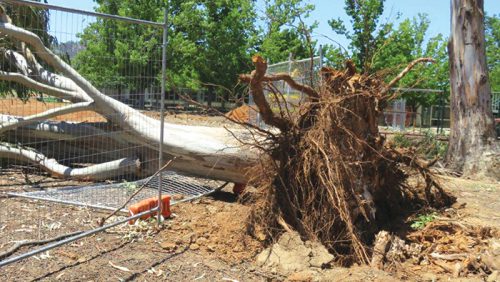WOW, what a storm; I thought the roof of our carport was going to head skywards.
It stopped almost as soon as it started, but the damage was unbelievable.

Usually it’s the eucalypts that crash, but on this occasion trees were mostly okay around me, except for an extremely large eucalypt that came down in the children’s playground at the Majura Primary School in Watson.
The wonderful rain last winter and early spring led us into a state of complacency about the weather. Summer has hit us and our plants hard with record high temperatures that are, seemingly, going on forever.
Gardens with drip irrigation systems have survived very well. But memories are short in good seasons. For those who water by hand or overhead sprinkler systems, most of the water is lost to evaporation. These methods of watering may make you feel good, however the chances of sufficient moisture reaching the roots of the plant is almost nil.
It is never too late to install a dripper irrigation system given that Canberra’s average annual rainfall is 620mm but, frighteningly, the average annual moisture loss from evaporation is a massive 1800mm plus almost certainly an equally big water bill!
AUTUMN is planting time. By planting in the heat of summer, especially this year, plants battle heat and desiccating winds. Below ground, bulbs, corms and tubers are unaffected, but above ground the larger the leaf, the more a plant is affected.

Unlike other places in the world, where permafrost can freeze soil up to a metre deep, Canberra soils freeze only to a depth of about 5cm, with the soil staying relatively warm.
As a result, with regular watering, the roots of plants continue to develop all through winter. Once spring arrives new growth really takes off.
Bulb planting can get under way right now until the middle of April, but given February is traditionally our hottest month, it might be wise to prepare the soil, but delay planting shrubs until the weather cools in late March or April.
When planting or relocating trees, it’s also vitally important to know the location of underground services, ie gas, water, electricity, phone and power. For a new home, plans should indicate these services. Otherwise, access the free national referral service Dial Before You Dig to prevent expensive damage to services at 1100.com.au or call 1100.
SILVER-leafed shrubs provide a wonderful contrast against green foliage of flowers in the garden. As an example, Acacia convenyi has been combined with the fire-engine red of Callistemon “Endeavour”.
By pruning, the convenyi can be kept as a medium shrub of, say, 3m or allowed to grow as a small tree 5-6m tall.
Golden-yellow flowers are on axillary sprays in spring presenting an even more spectacular sight against the silver foliage. The foliage is in popular demand for floral arrangements. It is native to most of NSW and is frost and drought hardy.
Other silver or grey foliage plants include Cistus “Sunset” or the very hardy rock rose, with pink flowers, all of the lavender family, especially Lavendula “Hidcote” or the dwarf Lavendula “Munstead”, which flower in summer and have the most fragrance of any lavenders. They are perfect for making pot pourri.
ANY silver or grey-leafed plants, or those with very small leaves, are very drought and sun hardy, losing little evaporation through the leaves, such as rosemary and thyme.
In the grey-leafed theme Thymus lanigerum or grey woolly thyme combined with members of the dianthus family make ideal plants for the front of the garden bed.
Dianthus “Doris” comes to immediate mind with possibly Convolvulus cneorum with silver-grey foliage and white flowers planted behind. A popular silver-leaved, border plant is Santolina chamaecyparissus with its tiny, yellow-button flowers en masse. It grows to about 40cm-50cm tall. The only disadvantage is that once it comes into flower, all the stems go into a swirl.
Once the flowers finish it is necessary to cut it back hard leaving the plant slightly unsightly for a month or so until the new growth starts.
Jottings…
• Now’s the time to cut hellebores to ground level. This may seem drastic, but this allows plenty of sunlight to the base of the plant, so important for flowering in winter.
• Likewise, although not quite so severe, cut back leaves now to about 75-100mm long of iris unguicularis or winter iris for winter flowering.
• Keep the bird bath topped up for birds to drink and wash.
Who can be trusted?
In a world of spin and confusion, there’s never been a more important time to support independent journalism in Canberra.
If you trust our work online and want to enforce the power of independent voices, I invite you to make a small contribution.
Every dollar of support is invested back into our journalism to help keep citynews.com.au strong and free.
Thank you,
Ian Meikle, editor




Leave a Reply